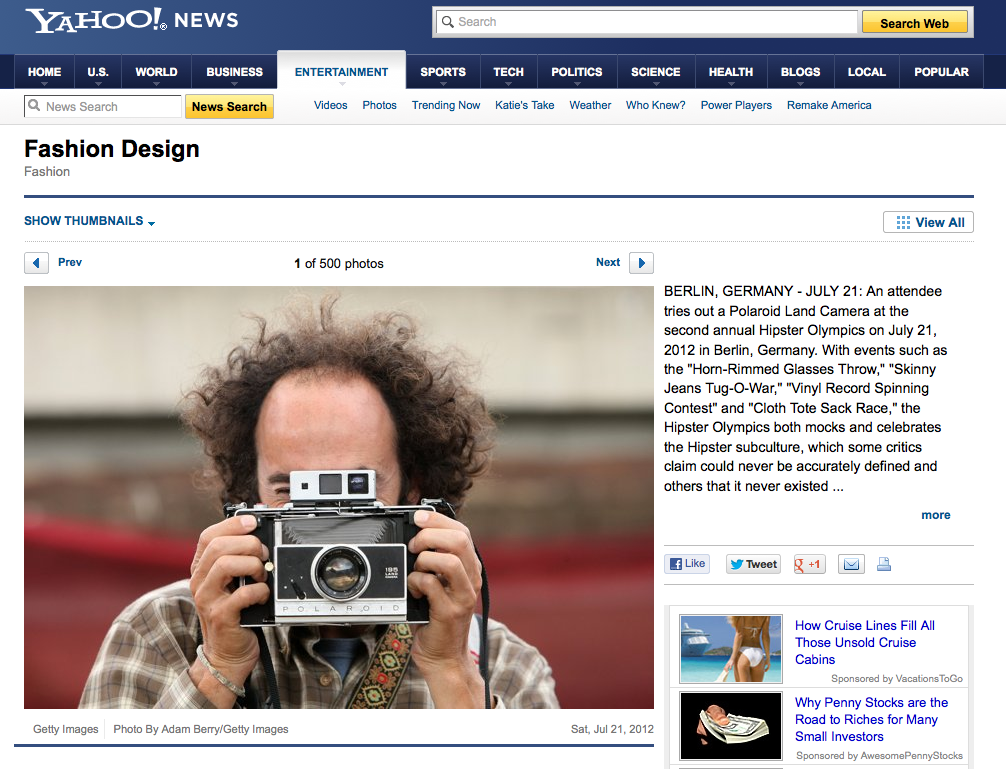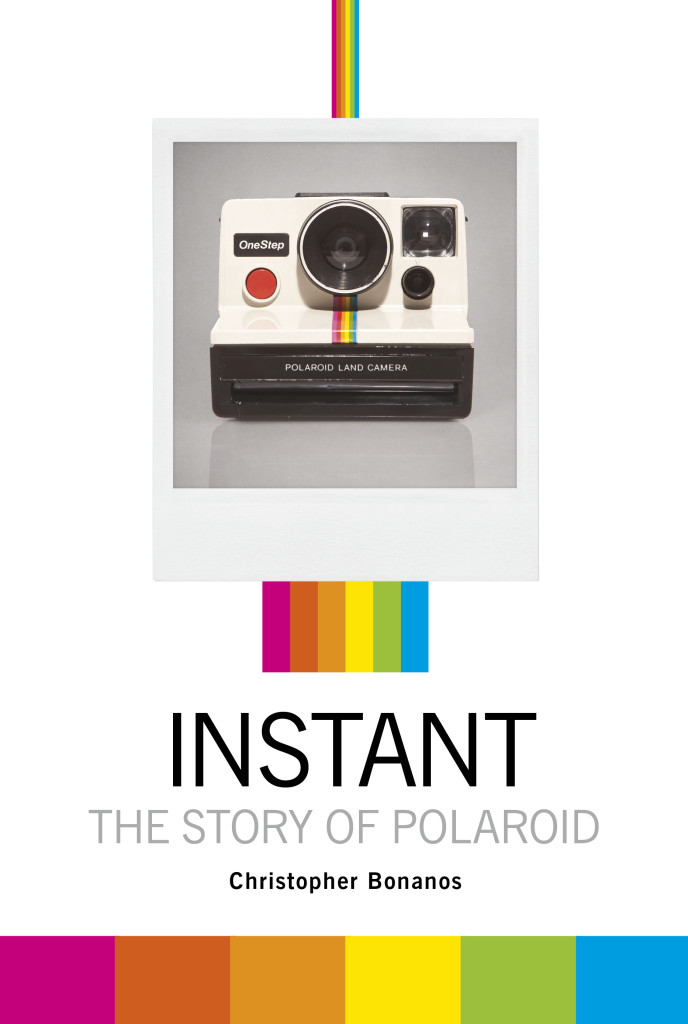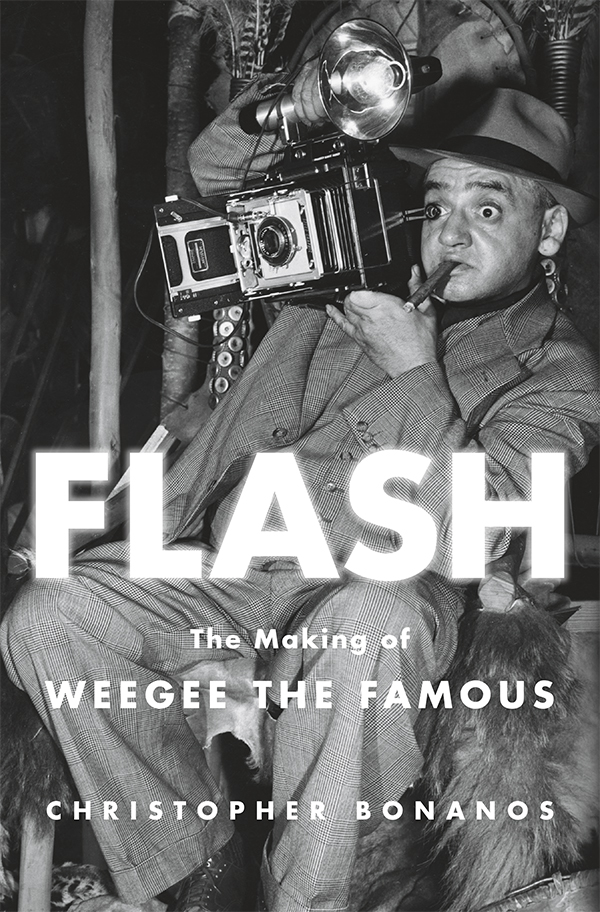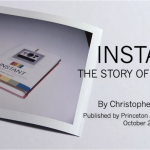The Polaroid Big Shot—Andy Warhol’s portrait camera of choice in the early seventies—has been discussed here before. Well, for a story this week, my visual-department colleagues at New York magazine (without any influence from me, by the way) arranged for photographer Lucas Michael to shoot Gina Gershon in the manner of Andy, with a vintage Big Shot. The results are fan-freaking-tastic, and G.G. looks like the bombshell she has always been.
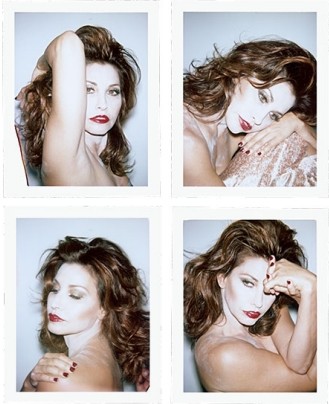 I have noticed that the Fresnel-focused flashbulb arrangement on that camera is quite kind to human skin. Web version linked above is good, but the print edition of the magazine shows the photos off to their best.
I have noticed that the Fresnel-focused flashbulb arrangement on that camera is quite kind to human skin. Web version linked above is good, but the print edition of the magazine shows the photos off to their best.
It was in Berlin last week. (“Yeah, it was pretty obscure. You probably don’t know about it.”)
And what did Yahoo! News use to signify the whole thing? I think you, as a Polaroidland visitor, can probably guess.
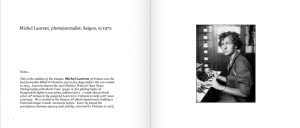
This is Michel Laurent, who won a Pulitzer for his Vietnam coverage in 1972. He was killed in 1975, just days before the war ended.
Neil Ulevich was a photographer working for the AP in Vietnam from 1972 to 1975. He brought a pack-film Polaroid camera with him, and says that in the press corps, “nobody took [it] seriously.” All the same, as a side project, he routinely asked his colleagues—from celebrated journalists to interpreters to the office cleaning lady—to pose for portraits. They’re collected in a new book, The Polaroid Portraits—Indochina 1972–1975, and a trip through the book is a taste not of the Vietnam landscape we’ve always seen but the working life of the guys (and a scattering of women) in the bureaus: polyester shirts, beat-up Nikons on neck straps, lots of facial scruff, and, frequently, the eye of the tiger. (Remember, these are people who made it their business to dive into war zones and return with rolls of film. Some of them didn’t make it home, either.) Hunter Thompson makes an appearance. Being that two of my major obsessions are the history of the press and the history of Polaroid, I can’t get enough of this. Buy yourself one.
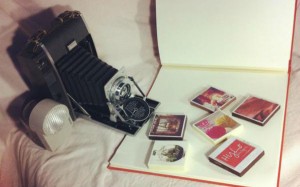 That’s right, the Cocoagraph: a chocolate bar printed with a color photo, complete with white Polaroid frame. More about the company here. That’s a Model 110A camera in the photo at left, so I get the sense that these people (or their photographer) are actual Polaroid enthusiasts.
That’s right, the Cocoagraph: a chocolate bar printed with a color photo, complete with white Polaroid frame. More about the company here. That’s a Model 110A camera in the photo at left, so I get the sense that these people (or their photographer) are actual Polaroid enthusiasts.
The thing for me to do would be to put the book jacket on one of these. Or, of course, an actual Polaroid photo. Of a Polaroid camera, even. Then take pictures of it. The chocolate would probably melt from sheer meta energy.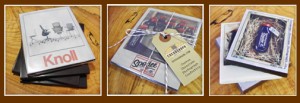
By 2000, I think it’s fair to say, the dream was over at Polaroid. The debt load was getting bigger and the digital-photo tidal wave that had been mounting for twenty years was cresting. In the absence of a great new idea coming out of the labs, Polaroid’s chairman and CEO, Gary DiCamillo, pursued a strategy of pumping out new products based on existing technology. It was a throw-it-against-the-wall-and-see-what-sticks strategy, and one thing did in fact stick: the Polaroid i-Zone.
And Britney was the spokesteen, y’all! And they made a video for it!
It was a little camera, about the dimensions of an office desk stapler, and it made photos the size of a conventional 135 slide or negative: 24 by 36 millimeters. You pulled them out of the camera on long paper tabs, as you can occasionally see in the video above. One variant of the film had the photos on an adhesive backing, so your pictures turned into stickers. And it was a smash. Teenagers and even younger kids loved it; adults were charmed.
Both Polaroid and Britney fell apart a few years later. Jury’s still out on both comebacks, though I wouldn’t count either one out yet.
 Nifty post here from the Film Photography Project, tipping me to a piece of gear I had not seen: Polaroid’s slide printers. You slip your 35-mm. slide into a little slot, fire the shutter, and it’s printed on Polaroid (or, now, Fuji) pack film. It’s pegged to 100-speed film, so you are limited to Fuji’s color film or the out-of-production FP-100B, but if you’re doing this chances are you’re more interested in the process than in distinctions like that. Will keep an eye out for one of these printers–between the diminishing interest of slides and the diminished use of Polaroid pack film, I have to assume they’re not selling for a lot of money these days.
Nifty post here from the Film Photography Project, tipping me to a piece of gear I had not seen: Polaroid’s slide printers. You slip your 35-mm. slide into a little slot, fire the shutter, and it’s printed on Polaroid (or, now, Fuji) pack film. It’s pegged to 100-speed film, so you are limited to Fuji’s color film or the out-of-production FP-100B, but if you’re doing this chances are you’re more interested in the process than in distinctions like that. Will keep an eye out for one of these printers–between the diminishing interest of slides and the diminished use of Polaroid pack film, I have to assume they’re not selling for a lot of money these days.
LEGALITIES
This site is not connected with or endorsed by Polaroid or PLR IP Holdings, owners of the Polaroid trademark.ON TWITTER
My TweetsBlogroll
- 'Insisting on the Impossible'
- Everything Reminds Me of You
- Flickr's Polaroid group
- Instant Options
- LandCameras.com
- Paul Giambarba: Analog Photography At Its Best
- Paul Giambarba: The Branding of Polaroid
- Polaroid
- Polaroid SF
- Rare Medium
- The Impossible Project
- The Land List
- The New55 Project
- Vintage Instant

